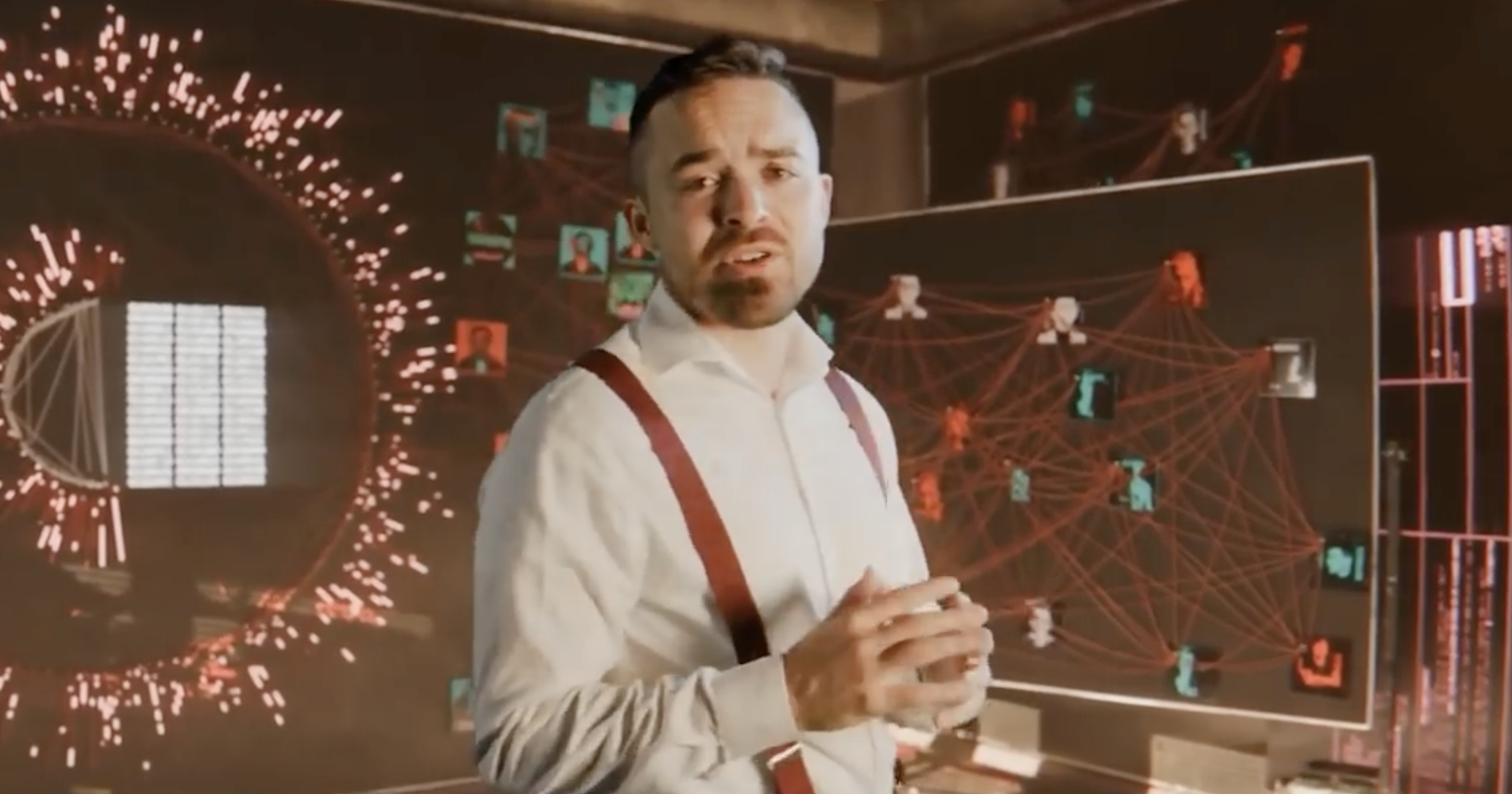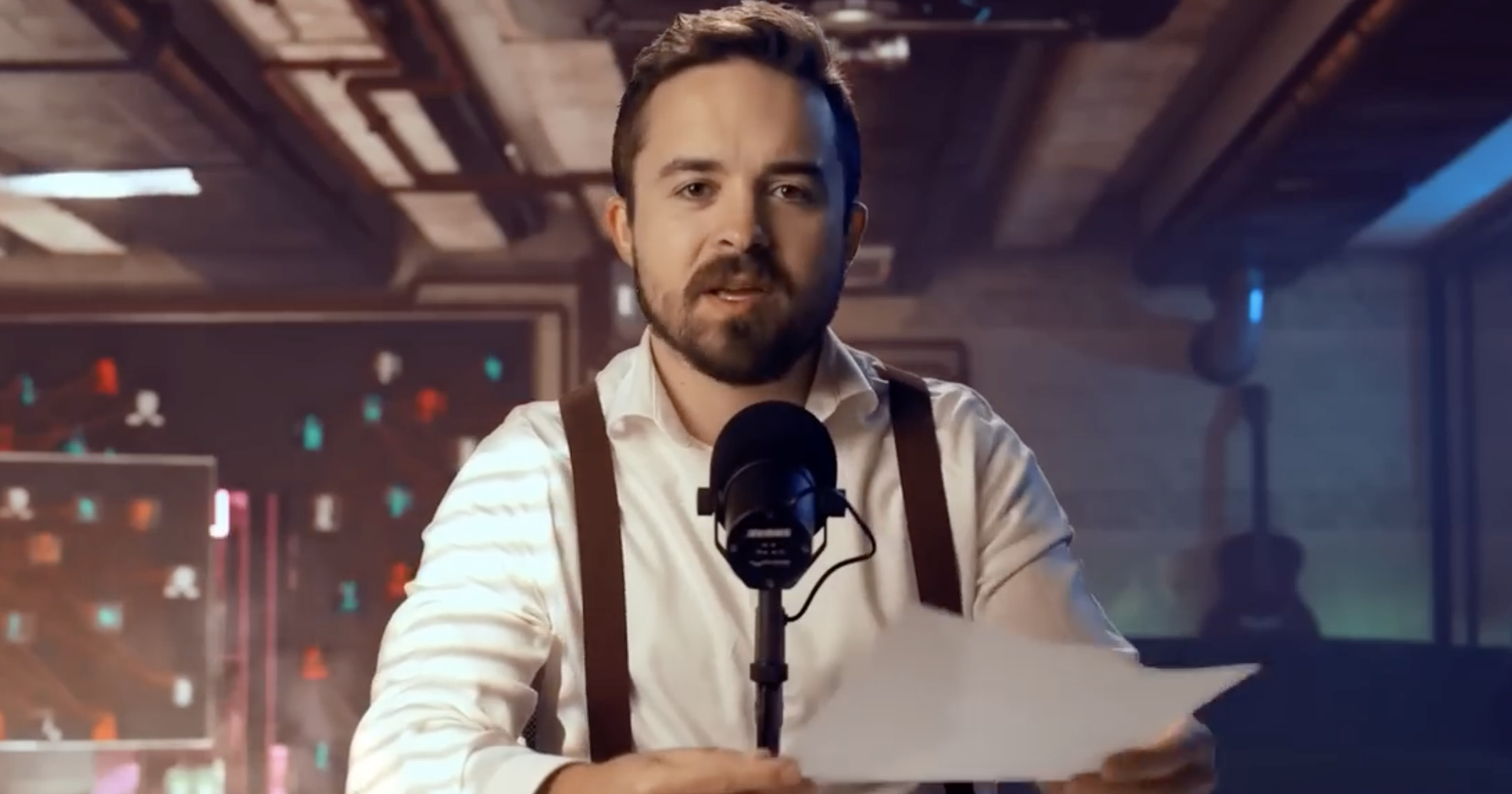
TL;DR
- Stephen Findeisen, aka Coffeezilla, is a YouTube content creator with more than three million subscribers known for debunking online scams.
- Coffeezilla’s content is set against a virtual backdrop of a cyberpunk, film noir-inspired city, created within a sophisticated virtual production environment humorously dubbed “the $10 million studio.”
- Starting with no background in production or film, Coffeezilla was inspired by other YouTubers and a TED Talk by David Korins, leading Findeisen to explore virtual production to create original content.
- Coffeezilla combines practical lighting solutions, like Aputure’s gobo cutouts, with post-production visual effects to enhance the realism of his virtual sets.
- Coffeezilla’s approach offers insights into the future of virtual production for indie creators, highlighting the potential for innovation within resource constraints.
Stephen Findeisen, known online as Coffeezilla, is a figure of intrigue and respect on YouTube. With a subscriber count north of three million, he’s renowned for debunking online scams, primarily within the crypto space. Yet, it’s not just his investigative prowess that sets him apart — it’s the virtual world he’s crafted for his content. This cyberpunk, film noir-inspired city, complete with a detective’s office, is where Coffeezilla’s stories come to life.
Findeisen generally records his videos in front of a green screen; his backgrounds feature elaborate computer graphics, and he inserts animated graphics to illustrate his content, including a recurring character of a robot bartender. This elaborate world is crafted inside what he has jokingly dubbed “the $10 million studio,” a high-tech virtual production environment run by a lean three-person team.
Findeisen recently sat down with VP Land’s Joey Daoud to recount his journey from a basic bedroom setup to a sophisticated production powerhouse, revealing tips and tricks and breaking down the virtual production studio he built for the Coffeezilla Cinematic Universe.
Go Big or Go Home
Embarking on YouTube with no background in production or film, Findeisen was driven by a desire to create something genuinely original that also informed his audience. Watching other YouTube channels like Linus Tech Tips and a TED Talk on set design by David Korins, who has designed sets for artists such as Kanye West, he was struck by the idea that one’s environment can shape their identity and creativity.
A breakthrough moment arrived when Findeisen realized he could create an infinite number of virtual production sets in his own bedroom. He began scouring the internet for information on virtual production, including behind-the-scenes videos for The Mandalorian. But while he was able to find plenty of details for big-budget productions employing virtual production techniques, there was very little guidance for indie productions.
“I remember thinking, really early on, I want to be one of the people who really pushes this landscape of indie virtual production forward in a practical way,” he tells Daoud. “I want to show that not only can it compete, it’s actually, I think, in a lot of cases more competitive, and people just sort of haven’t figured it out yet.”
Early experiments riffed off of tropes popularized by the internet scammers Findeisen featured to show off their fake wealth, such as placing a virtual Lamborghini inside his studio. “I just basically stole what they were doing and made it like a satire, like pastiche.” The idea of the $10 million studio started off as a joke, he says, until it wasn’t a joke anymore. “Because eventually, if you push your production enough, it is almost plausible that it’s a $10 million studio.”

Lights, Camera, Action
In the expansive realm of YouTube content creation, where the scale of production can range from solo vloggers to full-fledged studio teams, Coffeezilla has carved out a niche that defies the norm. At the heart of Findeisen’s operation is a lean three-person team — Findeisen himself, a 3D artist/animator, and a video editor.
Production time for a full show can range from a month to two months, depending on the complexity of the project and the amount of work done at the desk versus in-depth investigations. The production process is meticulous. It begins with research and script compilation, followed by storyboarding and shooting. “We’ll research stuff, then I’ll start to compile it in a script,” he describes. Post-production involves editing, sound design, and final touches. “We start to shoot it, then we send that to my editor… then we’ll send it for sound design and final editing.”
For capture, Findeisen opted for the Sony FX3 and FX9 full-frame cameras, augmented with the ARRI Alexa. Practical lighting solutions, such as Aputure‘s gobo cutouts, are employed to achieve specific visual effects, like Coffeezilla’s signature noir window blind lighting.
Open-source 3D software Blender serves as the backbone of Coffeezilla’s virtual set design. “I’ve just kind of always had a bad experience with Unreal, it never really runs fully real time on my computer,” he explains. “So I’m like, if we’re going to just have to do it in post, let’s just do it in Blender, because I think the renders out of Blender are slightly better.”
ICVFX vs Post-Production
Visual effects, such as the steam coming from Coffeezilla’s coffee mug, are also added in post. “I thought of so many ways to do that practically,” Findeisen laughs, recounting his process of trial and error with everything from fog machines to a boiling pot of wat placed underneath the desk. “If you if you like problem solving, virtual production is for you. Because it’s constant problem solving.”
All of Coffeezilla’s shots where he’s sitting at his desk speaking to the camera are final pixel, using Blender video renders of the room and composited in real time in Aximmetry, a node-based video editing solution for live workflows that allows the integration of live-action footage with virtual environments. “You basically pull in a camera input, but then you can apply a node layer,” he says, describing how camera correction, blur, color keys and more can be added to live footage in real time.
The more advanced VFX shots, such as conversations with his robot bartender or whenever the camera is moving, are composited later in post-production. Findeisen initially tried match moving, which tracks camera movement through a shot so it can be reproduced in 3D space, but found it to be tedious and repetitive.
“One thing with me is I’m always trying to cheat work,” he says with a laugh, describing how he’ll work all night just to avoid ever having to do the same thing twice. “Like, I’m always trying to make things faster. But then it ends up making me do more work.”
In the end, camera tracking, which analyzes data tracking the camera in physical space, provided the answer. Findeisen tested a number of tools, ultimately deciding on Mo-sys StarTracker, which he says delivers the closest thing to final pixel that he’s been able to find.
“It’s more about like figuring out how to solve for camera lens distortion on different lenses and like, you know, focus breathing, the things that you take for granted, or you don’t even realize are problems when you’re just trying to solve that tracking quality part.”
Findeisen also quickly learned the importance of practical elements in virtual sets. “Anything you touch on set should be practical. It’s so exhausting trying to manually track whatever stuff you touch, because you’re going to create all these shadows. It’s going to be a nightmare,” he says.
“Just do yourself a favor. Floors, try to make them practical. Things you touch, like chairs, or, like, if you’re touching a table, you know, please just make a practical cup, make it practical, these things are supposed to help you. And I think if you get too overly zealous about ‘I’m 100% virtual production,’ you’re going to be like me and trying to key out a green table where your arm’s touching it,” he cautions.
The Future of Indie Virtual Production
Findeisen also warns that indie virtual production for moving cameras may not be accessible to the layman YouTuber. “I’ve developed my pipeline as my resources have expanded,” he explains. “But I know when I started on YouTube, I could have never afforded the tools I needed for moving a camera. There’s just so much you need to get a working workflow for moving camera virtual production, that I think it’s worth being really honest about that,” he says.
It’s not just about the money, however; it’s also about time. “You can do a lot with a basic green screen, some basic lights and a camera. But as far as, like, trying to get into the moving camera shots, unless you’re willing to spend some time I think match moving is maybe the closest thing to a cheap workflow for that. But even then, it’s hard.”
Findeisen says that he’s come to appreciate green screen as a tool for simplifying workflows. “James Cameron, I think, is famous for saying, ‘on green screen, things that are hard in real life are easy. And things that are easy in real life are hard.’
“I think that’s really true. If you want some epic sweep of the Himalayan Mountains, you could build it on Fiverr with a CG artist for five bucks in, like, five minutes. Or you could hire a helicopter to go out there and shoot it for real on an ARRI Alexa. So they’re very two different things in scope. But if you want to have a person open a door and walk through it, fully in CG, it’s actually pretty hard. And if you want to do that, practically, it’s so easy,” he explains.
“Nobody comes to my videos thinking, ‘Oh, I’m gonna see virtual production today.’ It’s just this invisible tool that just helps things look a little bit better, helps the narrative flow a bit better. And I’m happy to have that in the background.”

